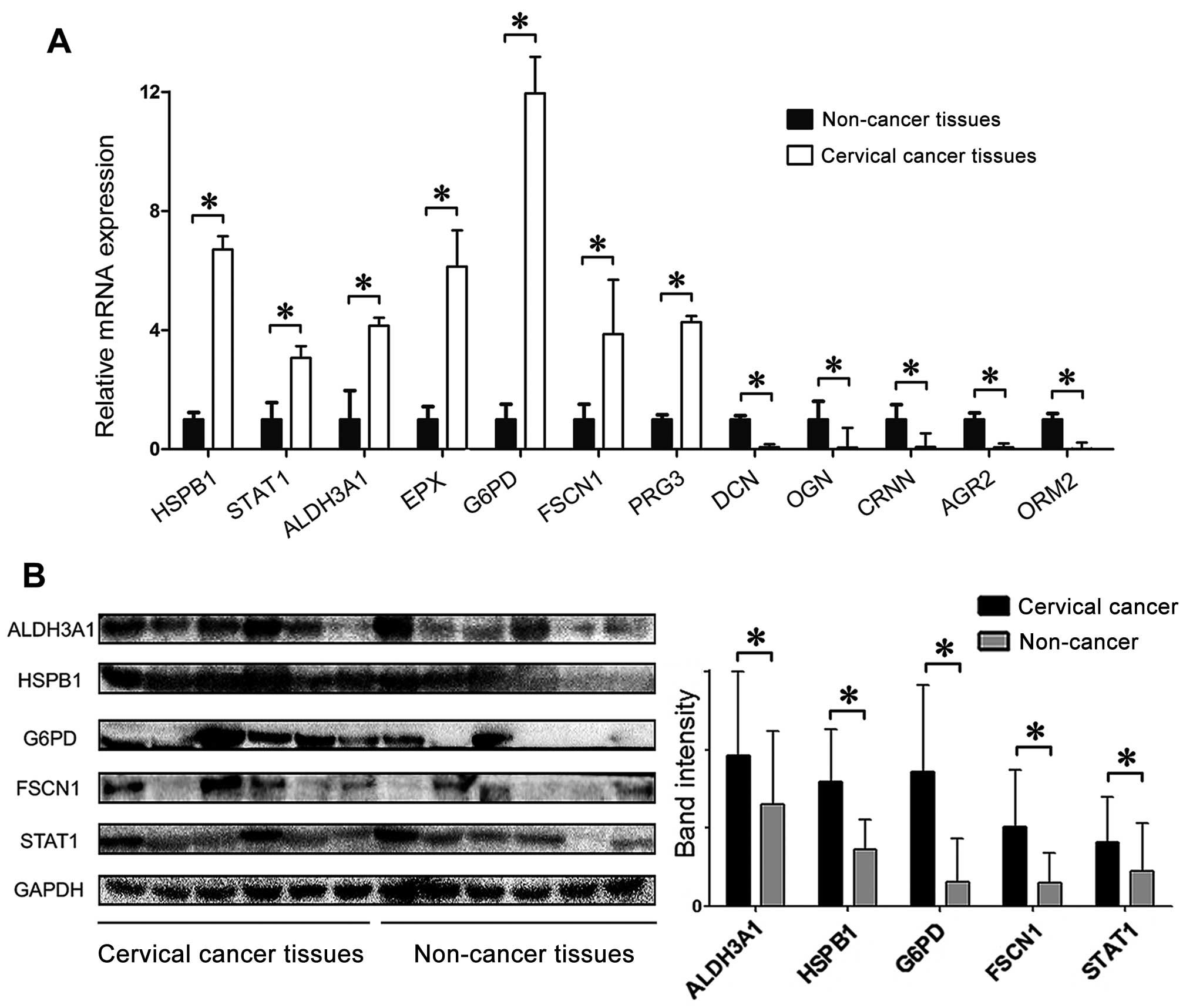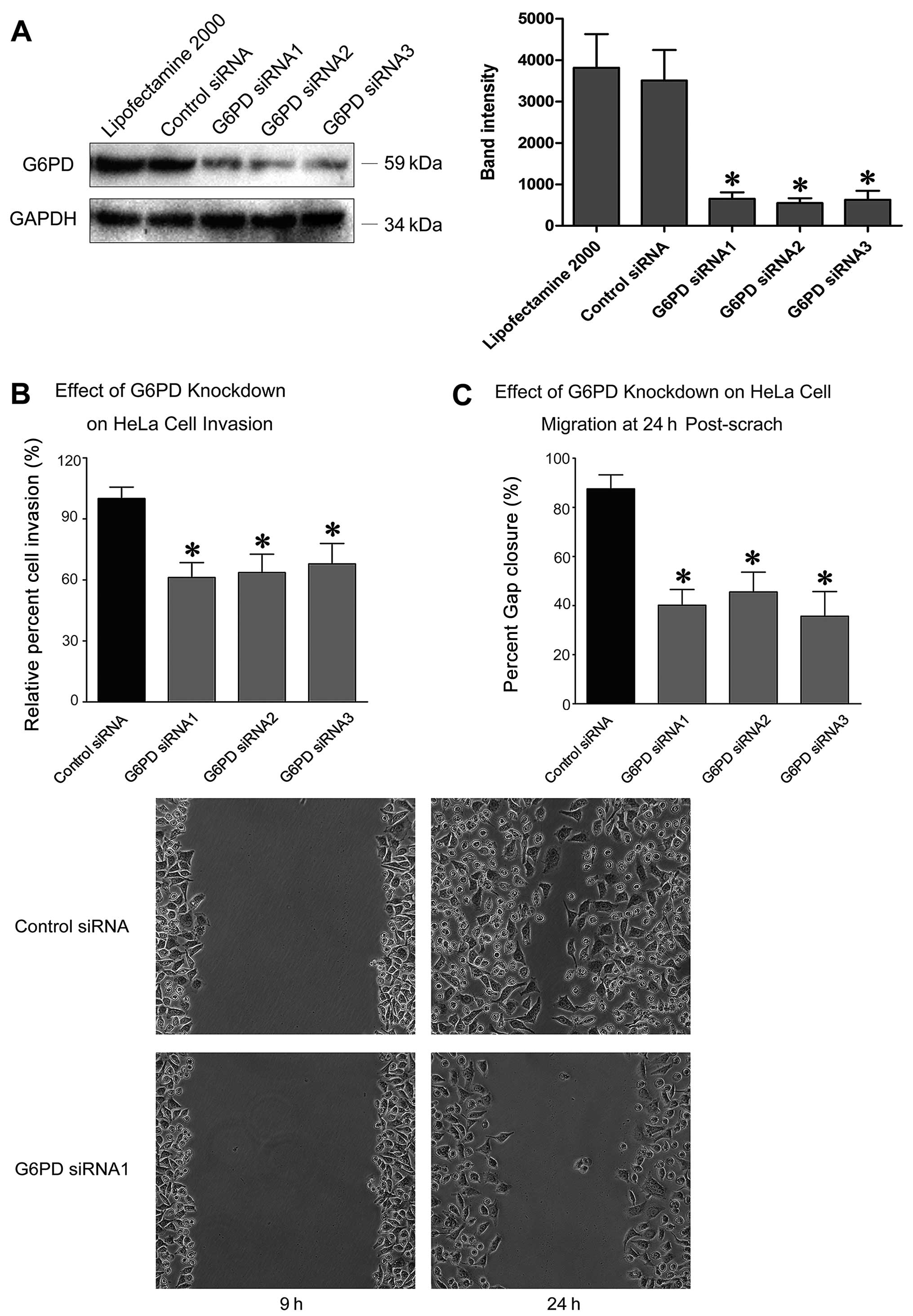|
1
|
Parkin DM, Pisani P and Ferlay J:
Estimates of the worldwide incidence of eighteen major cancers in
1985. Int J Cancer. 54:594–606. 1993. View Article : Google Scholar : PubMed/NCBI
|
|
2
|
Ferlay J, Shin HR, Bray F, Forman D,
Mathers C and Parkin DM: Estimates of worldwide burden of cancer in
2008. Int J Cancer. 127:2893–2917. 2010. View Article : Google Scholar
|
|
3
|
Munoz N, Bosch FX, de Sanjose S, et al:
The causal link between human papillomavirus and invasive cervical
cancer: a population-based case-control study in Colombia and
Spain. Int J Cancer. 52:743–749. 1992. View Article : Google Scholar : PubMed/NCBI
|
|
4
|
Schiffman MH, Bauer HM, Hoover RN, et al:
Epidemiologic evidence showing that human papillomavirus infection
causes most cervical intraepithelial neoplasia. J Natl Cancer Inst.
85:958–964. 1993. View Article : Google Scholar : PubMed/NCBI
|
|
5
|
Franco E, Syrjanen K, de Wolf C, et al:
New developments in cervical cancer screening and prevention;
Geneva, Switzerland. June 17–19 1996; Workshop. Cancer Epidemiol
Biomarkers Prev. 5. pp. 853–856. 1996
|
|
6
|
Franco EL: Measurement errors in
epidemiological studies of human papillomavirus and cervical
cancer. IARC Sci Publ. 119:181–197. 1992.PubMed/NCBI
|
|
7
|
Sun W, Xing B, Sun Y, et al: Proteome
analysis of hepatocellular carcinoma by two-dimensional difference
gel electrophoresis: novel protein markers in hepatocellular
carcinoma tissues. Mol Cell Proteomics. 6:1798–1808. 2006.
View Article : Google Scholar
|
|
8
|
Bae SM, Lee CH, Cho YL, Nam KH, Kim YW,
Kim CK, Han BD, Lee YJ, Chun HJ and Ahn WS: Two-dimensional gel
analysis of protein expression profile in squamous cervical cancer
patients. Gynecol Oncol. 99:26–35. 2005. View Article : Google Scholar : PubMed/NCBI
|
|
9
|
Bae SM, Min HJ, Ding GH, et al: Protein
expression profile using two-dimensional gel analysis in squamous
cervical cancer patients. Cancer Res Treat. 38:99–107. 2006.
View Article : Google Scholar : PubMed/NCBI
|
|
10
|
Abdul-Rahman PS, Lim BK and Hashim OH:
Expression of high-abundance proteins in sera of patients with
endometrial and cervical cancers: analysis using 2-DE with silver
staining and lectin detection methods. Electrophoresis.
28:1989–1996. 2007. View Article : Google Scholar : PubMed/NCBI
|
|
11
|
Görg A, Obermaier C, Boguth G, Harder A,
Scheibe B, Wildgruber R and Weiss W: The current state of
two-dimensional electrophoresis with immobilized pH gradients.
Electrophoresis. 21:1037–1053. 2007. View Article : Google Scholar
|
|
12
|
Fu C, Wu C, Liu T, Ago T, Zhai P,
Sadoshima J and Li H: Elucidation of thioredoxin target protein
networks in mouse. Mol Cell Proteomics. 8:1674–1687. 2009.
View Article : Google Scholar : PubMed/NCBI
|
|
13
|
Rangiah K, Tippornwong M, Sangar V, Austin
D, Tétreault MP, Rustgi AK, Blair IA and Yu K: Differential
secreted proteome approach in murine model for candidate biomarker
discovery in colon cancer. J Proteome Res. 8:5153–5164. 2009.
View Article : Google Scholar : PubMed/NCBI
|
|
14
|
Ross PL, Huang YN, Marchese JN, et al:
Multiplexed protein quantization in Saccharomyces cerevisiae using
amine-reactive isobaric tagging reagents. Mol Cell Proteomics.
3:1154–1169. 2004. View Article : Google Scholar : PubMed/NCBI
|
|
15
|
Yang Y, Toy W, Choong LY, Hou P, Ashktorab
H, Smoot DT, Yeoh KG and Lim YP: Discovery of SLC3A2 cell membrane
protein as a potential gastric cancer biomarker: implications in
molecular imaging. J Proteome Res. 1:5736–5747. 2012.
|
|
16
|
Chen Y, Choong LY, Lin Q, et al:
Differential expression of novel tyrosine kinase substrates during
breast cancer development. Mol Cell Proteomics. 6:2072–2087. 2007.
View Article : Google Scholar : PubMed/NCBI
|
|
17
|
Chong PK, Lee H, Zhou J, Liu SC, Loh MC,
So JB, Lim KH, Yeoh KG and Lim YP: Reduced plasma APOA1 level is
associated with gastric tumor growth in MKN45 mouse xenograft
model. J Proteomics. 73:1632–1640. 2010. View Article : Google Scholar : PubMed/NCBI
|
|
18
|
Fujii K, Kondo T, Yokoo H, Yamada T,
Iwatsuki K and Hirohashi S: Proteomic study of human hepatocellular
carcinoma using two-dimensional difference gel electrophoresis with
saturation cysteine dye. J Proteomics. 5:1411–1422. 2005.
View Article : Google Scholar
|
|
19
|
Gan CS, Chong PK, Pham TK and Wright PC:
Technical, experimental, and biological variations in isobaric tags
for relative and absolute quantitation (iTRAQ). J Proteome Res.
6:821–827. 2007. View Article : Google Scholar : PubMed/NCBI
|
|
20
|
Pandolfi PP, Sonati F, Rivi R, Mason P,
Grosveld F and Luzzatto L: Targeted disruption of the housekeeping
gene encoding glucose 6-phosphate dehydrogenase (G6PD): G6PD is
dispensable for pentose synthesis but essential for defense against
oxidative stress. EMBO J. 14:5209–5215. 1995.PubMed/NCBI
|
|
21
|
Hu T, Zhang C, Tang Q, Su Y, Li B, Chen L,
Zhang Z, Cai T and Zhu Y: Variant G6PD levels promote tumor cell
proliferation or apoptosis via the STAT3/5 pathway in the human
melanoma xenograft mouse model. BMC Cancer. 13:2512013. View Article : Google Scholar : PubMed/NCBI
|
|
22
|
Jiang P, Du W and Yang X: A critical role
of glucose-6-phosphate dehydrogenase in TAp73-mediated cell
proliferation. Cell Cycle. 12:3720–3726. 2013. View Article : Google Scholar : PubMed/NCBI
|
|
23
|
Lin HR, Wu CC, Wu YH, Hsu CW, Cheng ML and
Chiu DT: Proteome-wide dysregulation by glucose-6-phosphate
dehydrogenase (G6PD) reveals a novel protective role for G6PD in
aflatoxin B(1)-mediated cytotoxicity. J Proteome Res. 12:3434–3448.
2013. View Article : Google Scholar : PubMed/NCBI
|
|
24
|
DeBerardinis RJ, Lum JJ, Hatzivassiliou G
and Thompson CB: The biology of cancer: metabolic reprogramming
fuels cell growth and proliferation. Cell Metab. 7:11–20. 2008.
View Article : Google Scholar : PubMed/NCBI
|
|
25
|
Vander Heiden MG, Cantley LC and Thompson
CB: Understanding the Warburg effect: the metabolic requirements of
cell proliferation. Science. 324:1029–1033. 2009. View Article : Google Scholar : PubMed/NCBI
|
|
26
|
Jiang P, Du W, Wang X, Mancuso A, Gao X,
Wu M and Yang X: p53 regulates biosynthesis through direct
inactivation of glucose-6 -phosphate dehydrogenase. Nat Cell Biol.
13:310–316. 2011. View
Article : Google Scholar : PubMed/NCBI
|
|
27
|
Berg J, Tymoczko J and Stryer L:
Biochemistry. 6th edition. WH Freeman & Co; New York, NY: pp.
577–589. 2006
|
|
28
|
Hix LM, Karavitis J, Khan MW, Shi YH,
Khazaie K and Zhang M: Tumor STAT1 transcription factor activity
enhances breast tumor growth and immune suppression mediated by
myeloid-derived suppressor cells. J Biol Chem. 288:11676–11688.
2013. View Article : Google Scholar : PubMed/NCBI
|
|
29
|
Zhang M: Novel function of STAT1 in breast
cancer. Oncoimmunology. 2:e251252013. View Article : Google Scholar : PubMed/NCBI
|
|
30
|
Rajkumar T, Sabitha K, Vijayalakshmi N,
Shirley S, Bose MV, Gopal G and Selvaluxmy G: Identification and
validation of genes involved in cervical tumourigenesis. BMC
Cancer. 11:802011. View Article : Google Scholar : PubMed/NCBI
|
|
31
|
Altieri DC: Survivin, versatile modulation
of cell division and apoptosis in cancer. Oncogene. 22:8581–8589.
2003. View Article : Google Scholar : PubMed/NCBI
|
|
32
|
Ciocca DR and Calderwood SK: Heat shock
proteins in cancer: diagnostic, prognostic, predictive, and
treatment implications. Cell Stress Chaperones. 10:86–103. 2005.
View Article : Google Scholar : PubMed/NCBI
|
|
33
|
Cory S, Huang DC and Adams JM: The Bcl-2
family: roles in cell survival and oncogenesis. Oncogene.
22:8590–8607. 2003. View Article : Google Scholar : PubMed/NCBI
|
|
34
|
Romanucci M, Marinelli A, Sarli G and
Della Salda L: Heat shock protein expression in canine malignant
mammary tumours. BMC Cancer. 6:1712006. View Article : Google Scholar : PubMed/NCBI
|
|
35
|
Bruey JM, Ducasse C, Bonniaud P, et al:
Hsp27 negatively regulates cell death by interacting with
cytochrome. Nat Cell Biol. 2:645–652. 2000. View Article : Google Scholar : PubMed/NCBI
|
|
36
|
Cornford PA, Dodson AR, Parsons KF,
Desmond AD, Woolfenden A, Fordham M, Neoptolemos JP, Ke Y and
Foster CS: Heat shock protein expression independently predicts
clinical outcome in prostate cancer. Cancer Res. 60:7099–7105.
2000.
|
|
37
|
Cohen M, Dromard M and Petignat P: Heat
shock proteins in ovarian cancer: a potential target for therapy.
Gynecol Oncol. 119:164–166. 2010. View Article : Google Scholar : PubMed/NCBI
|
|
38
|
McCollum AK, Teneyck CJ, Sauer BM, Toft DO
and Erlichman C: Up-regulation of heat shock protein 27 induces
resistance to 17-allylamino-demethoxygeldanamycin through a
glutathione-mediated mechanism. Cancer Res. 66:10967–10975. 2006.
View Article : Google Scholar : PubMed/NCBI
|
|
39
|
Vasiliou V and Nebert DW: Analysis and
update of the human aldehyde dehydrogenase (ALDH) gene family. Hum
Genomics. 2:138–143. 2005.PubMed/NCBI
|
|
40
|
Vasiliou V, Pappa A and Estey T: Role of
human aldehyde dehydrogenases in endobiotic and xenobiotic
metabolism. Drug Metab Rev. 36:279–299. 2004. View Article : Google Scholar : PubMed/NCBI
|
|
41
|
Canuto RA, Muzio G, Ferro M, Maggiora M,
Federa R, Bassi AM, Lindahl R and Dianzani MU: Inhibition of
class-3 aldehyde dehydrogenase and cell growth by restored lipid
peroxidation in hepatoma cell lines. Free Radic Biol Med.
26:333–340. 1999. View Article : Google Scholar : PubMed/NCBI
|
|
42
|
Muzio G, Trombetta A, Maggiora M,
Martinasso G, Vasiliou V, Lassen N and Canuto RA: Arachidonic acid
suppresses growth of human lung tumor A549 cells through
down-regulation of ALDH3A1 expression. Free Radic Biol Med.
40:1929–1938. 2006. View Article : Google Scholar : PubMed/NCBI
|















